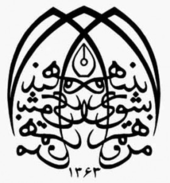Supreme Council of the Cultural Revolution
| Supreme Council of the Cultural Revolution شورای عالی انقلاب فرهنگی | |
|---|---|
 | |
| Type | |
| Type | |
| Leadership | |
Chairman | |
Secretary |
Mohammad Reza Mokhber Since 5 July 2011 |
| Seats | 41 |
| Meeting place | |
| Tehran, Iran | |
| Website | |
| iranculture.org | |
Supreme Council of the Cultural Revolution (also known as The Supreme Cultural Revolution Council or SCRC) (in Persian: شورای عالی انقلاب فرهنگی), is a conservative-dominated body based in Qom, was set up at the time of Ayatollah Khomeini. Its decisions can only be overruled by Iran's Supreme Leader. Most of its members were appointed by Ali Khamenei, Khomeini's successor.
The President of Iran is ex officio the chairman of the Council.
History
| This article is part of a series on the |
| Politics of the Islamic Republic of Iran |
|---|
 |
| Government of Islamic Republic of Iran |
|
Supreme Councils |
|
Local governments |
|
|
|
The Supreme Cultural Revolution Council that was formed in December 1984 was in fact continuation of the Cultural Revolution Headquarters.
This council debates and approves its own relevant issues. The Khomeini used to say that such approved issues must be regarded as laws. He did not mean that Supreme Council of the Cultural Revolution was a legislative organ. However, its ratified bills are valid as approved laws. In accordance with the instructions of the late Khomeini, one must not overrule the approved issues of this council.
The headquarters took shape on 12 June 1980 and following a decree by Khomeini the council was charged to take measures in planning for various courses and for the cultural policy of the universities in future on the basis of Islamic culture and through selection of efficient, committed and vigilant professors and for other issues relevant to the Islamic academic revolution.
[1]
The Cultural Revolution Headquarters failed to make universities ready for building the future. The headquarters deleted certain courses such as music as "fake knowledge." Committees established after the 1979 Revolution came to similar conclusions concerning all subjects in the humanities such as law, political sciences, economy, psychology, education and sociology.
The SCRC was formed in December 1984 and substituted the Cultural Revolution Headquarters. In fact, the formation of such an institution was not stipulated in the Constitution. It was formed under the special circumstances that were prevailing in the early stages of the revolution. The council took its legitimacy from the 9 December 1984 decree of the founder of the Islamic Republic Ayatollah Khomeini.
Following the formation of the SCRC, it declared itself the highest body for making policies and decisions in connection with cultural, educational and research activities within the framework of the general policies of the system and considered its approvals indispensable. In fact, the group of 7 (in 1980-83, and then 17 in 1984, and expanded to 36 in 1999) was expected to compile all the cultural policies of the country.
The SCRC blocked the way to the emergence of the student movement in 1983-1989 period by banning many books and purging thousands of students and lecturers. Through selection of applicants who wished to enter universities and by the formation of institutions inside universities, the council took control of the affairs of all university students.
In 1996 Hojjateslam Mohammad Khatami was appointed as a member of High Council for Cultural Revolution by the Supreme Leader of Iran. As President he was the head of the council.
In October 2001 the SCRC ordered all private Internet access companies under state control. The order was never implemented, but parliament considered legislation that would require Internet providers to block access to adult sites and others.
On 10 June 2003, judiciary spokesman Gholam-Hossein Elham explained that a lack of adequate, government-imposed filtering would "pollute the climate" of Internet sites so that those seeking information would be put off from using the sites. They would thus be deprived of their natural rights to gain knowledge. Elham explained that an advisory committee of the SCRC would take charge of filtering. Elham listed more than 20 matters that would likely be filtered.[2]
As president, Mahmoud Ahmadinejad was appointed ex officio by the Supreme Leader of Iran as a member of High Council for Cultural Revolution in 2005. The president is by virtue of his position the chair of the council.
On 5 July 2011, Mohammad Reza Mokhber Dezfuli is elected as Secretary of Council by members of Council for four years.
Goals
The declared goal of the Supreme Council of the Cultural Revolution is to ensure that the education and culture of Iran remains "100% Islamic" as Ayatollah Khomeini directed. This includes working against outside "cultural influences" and ideologies.
Main Members of Cultural Revolution Headquarters
First core of Cultural Revolution Headquarters between 1980–1987
| Name | Title |
|---|---|
| Ruhollah Khomeini | Founder |
| Ali Khamenei | Founder and head of the council |
| Mohammad Javad Bahonar | member of council |
| Ahmad Ahmadi | |
| Jalaleddin Farsi | |
| Mehdi Golshani | |
| Hassan Habibi | |
| Ali Shariatmadari | |
| Abdolkarim Soroush | |
| Mostafa Moin | minister of science |
| Hassan Arefi | mostly involved in expelling medical scientists |
| Mohammad Ali Najafi | minister of science |
| Asadollah Lajevardi |
Current members
All the 41 members of council are selected by Supreme Leader of Iran.
Honorary Members
- Ahmad Jannati
- Hassan Habibi (Deceased)
Individual Members
- Ahmad Ahmadi
- Alireza Arafi
- Hamid Parsania
- Gholam-Ali Haddad-Adel
- Reza Davari Ardakani
- Hassan Rahimpour Azghadi
- Ali Shariatmadari
- Ali Akbar Rashad
- Seyed Alireza Sadr Hosseini
- Mohammad-Reza Aref
- Mohsen Ghomi
- Mohammad-Ali Key-Nejad
- Mansour Kabganian
- Hossein Kachooyan
- Mehdi Golshani
- Mahmoud Mohammadi Araghi
- Mohammad Reza Mokhber Dezfooli
- Sadegh Vaez-Zadeh
- Ali Akbar Velayati
Ex officio Members
- President of Iran - Hassan Rouhani - (Chairman)
- Chief of Justice - Sadeq Larijani
- Speaker of Parliament - Ali Larijani
- Ministry of Culture and Islamic Guidance - Ali Jannati
- Ministry of Health and Medical Education - Hassan Hashemi
- Ministry of Science, Research and Technology - Mohammad Farhadi
- Ministry of Education - Ali Asghar Fani
- Ministry of Youth Affairs and Sports - Mahmoud Goudarzi
- Vice-President of Technology and Scientific- Sorena Sattari
- Vice President in Strategic Planning and Budget- Mohammad Bagher Nobakht
- Vice-President for Women and Family Affairs- Shahindokht Molaverdi
- Islamic Republic of Iran Broadcasting - Abdulali Ali-Asgari
- Islamic Development Organization - Mehdi Khamooshi
- Islamic Communications and Cultural Organization - Mohammad Bagher Khoramshad
- Institute of Representativeness of Leadership in Universities - Mohammad Mohammadian
- Jihad of Collegiate - Hamid Tayyebi
- Council of Cultural and Social of Women - Kobra Khazali
- Islamic Azad University - Hamid Mirzadeh
- Cultural Board of Islamic Consultative Assembly - Nasrollah Pejmanfar
- Educational and Research Board of Islamic Consultative Assembly - Ali Abbaspoor
- Health and Medical Board of Islamic Consultative Assembly - Hossein Ali Shahriari
Important events
Iranian Cultural Revolution
The Cultural Revolution (1980–1983) (in Persian: Enqelābe Farhangi) was a period following the 1979 Islamic Revolution in Iran where the academia of Iran was purged of Western and non-Islamic influences to bring it in line with Shia Islam.[3] The official name used by the Islamic Republic is "Cultural Revolution."
Directed by the Cultural Revolutionary Headquarters, the revolution initially closed universities for three years (1980–1983) and after reopening banned many books and purged thousands of students and lecturers from the schools.[4] The cultural revolution involved a certain amount of violence in taking over the university campuses since higher education in Iran at the time was dominated by leftists forces opposed to Ayatollah Khomeini's vision of theocracy, and they (unsuccessfully) resisted Khomeiniist control at many universities. How many students or faculty were killed is not known.[3][5][6]
The process of purification of the education system of foreign influences has not been without sacrifice. In addition to interrupting the education and professional livelihood of many, and striking "a major blow to Iran's cultural and intellectual life and achievement",[7] it contributed to the emigration of many teachers and technocrats. The loss of job skills and capital has weakened Iran's economy.
After 2009 Iranian Election Protests
After 2009 Iranian Election Protests Iran's Supreme Council of Cultural Revolution announced in December 2009 that it had removed opposition leader Mir-Hossein Mousavi from his position as head of the Academy of Arts,[8] apparently at the behest of President Mahmoud Ahmadinejad.
Mousavi, a successful artist and architect, had been the head of the academy since it was founded in 1998 and even designed the building that houses it. Mousavi's removal from his post at the academy has provoked outrage from his colleagues, with 27 of 30 faculty members threatening to resign in solidarity, the faculty members who have sided with Mousavi include his wife, Zahra Rahnavard, celebrated miniaturist Mahmoud Farshchian and renowned film directors Majid Majidi and Dariush Mehrjui.[9]
See also
External links
References
- ↑ Etela'at Newspaper 6th Farvardin 1359 page 4
- ↑ GlobalSecurity website
- 1 2 "State-University Power Struggle at Times of Revolution and War in Iran"
- ↑ Supreme Cultural Revolution Council GlobalSecurity.org
- ↑ According to http://www.bc.edu/bc_org/avp/soe/cihe/newsletter/News36/text006.htm On 18 April 1980, "the gangs wounded hundreds of students and killed at least 24"
- ↑ http://www.mukto-mona.com/Articles/Younus_Sheikh/IslamWoman3.htm "There were 5,195 political and religious executions only in 1983 alone!"
- ↑ Keddie, Modern Iran, (2006), p.250
- ↑ Official Website of Academy of Arts of Iran
- ↑ Los Angeles Times